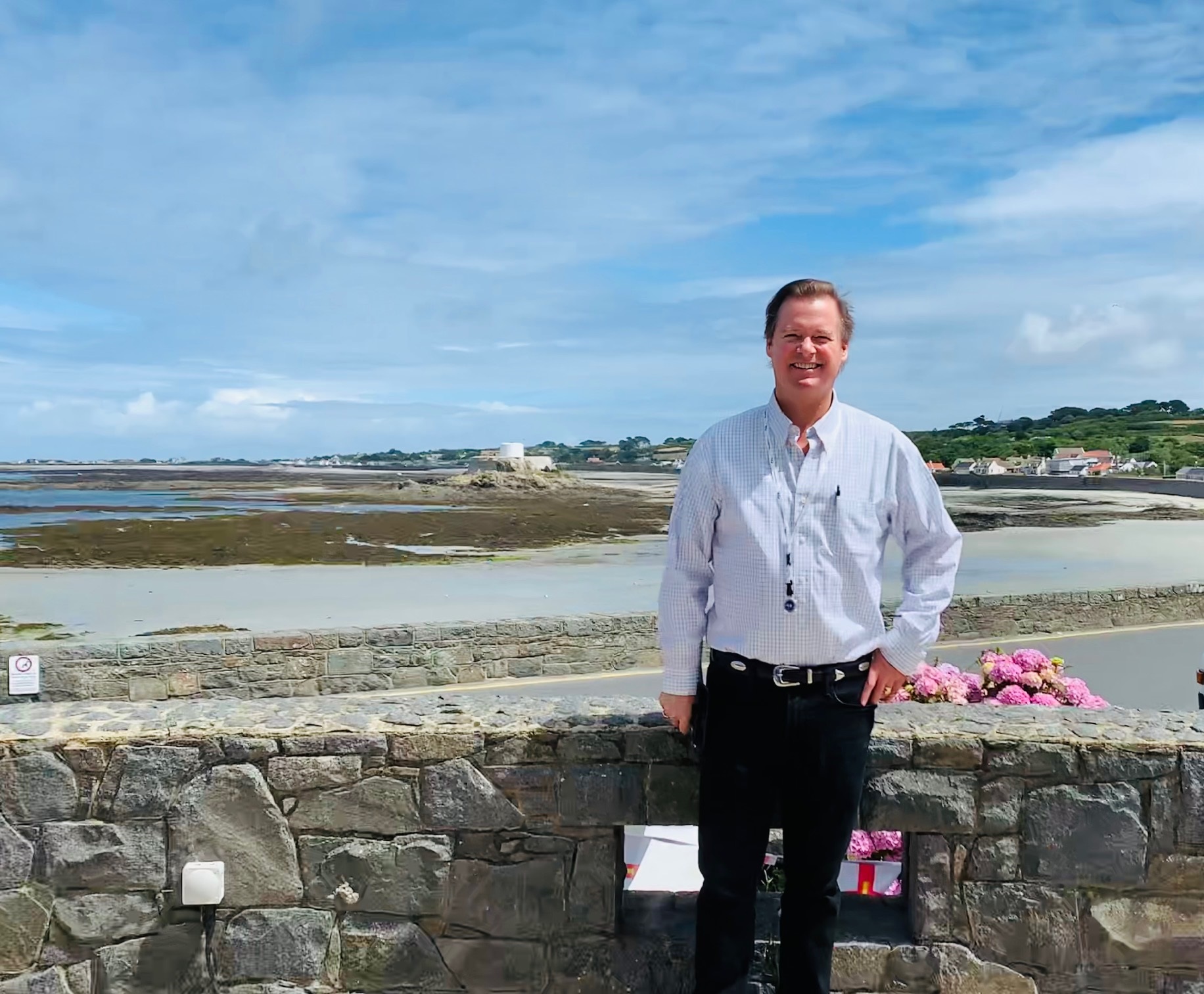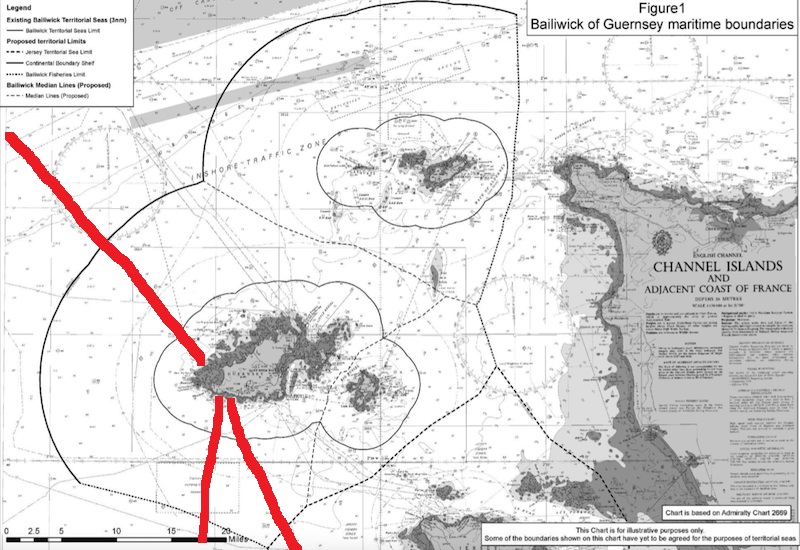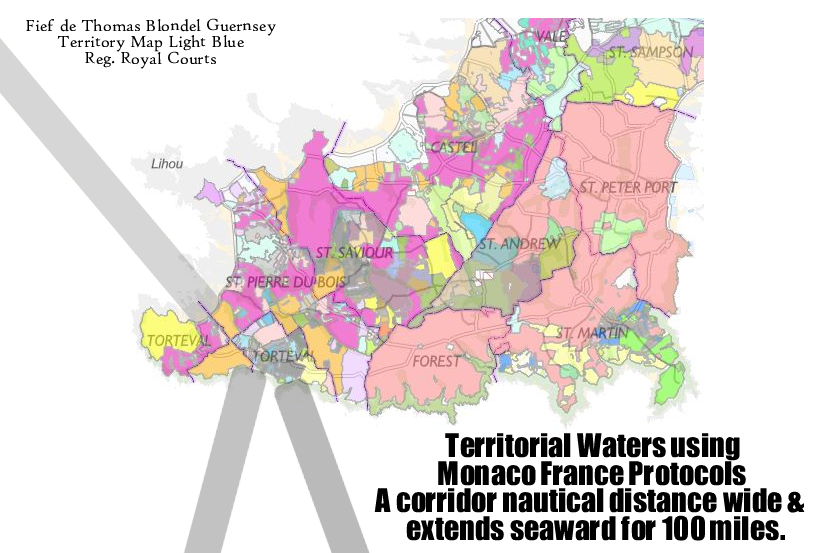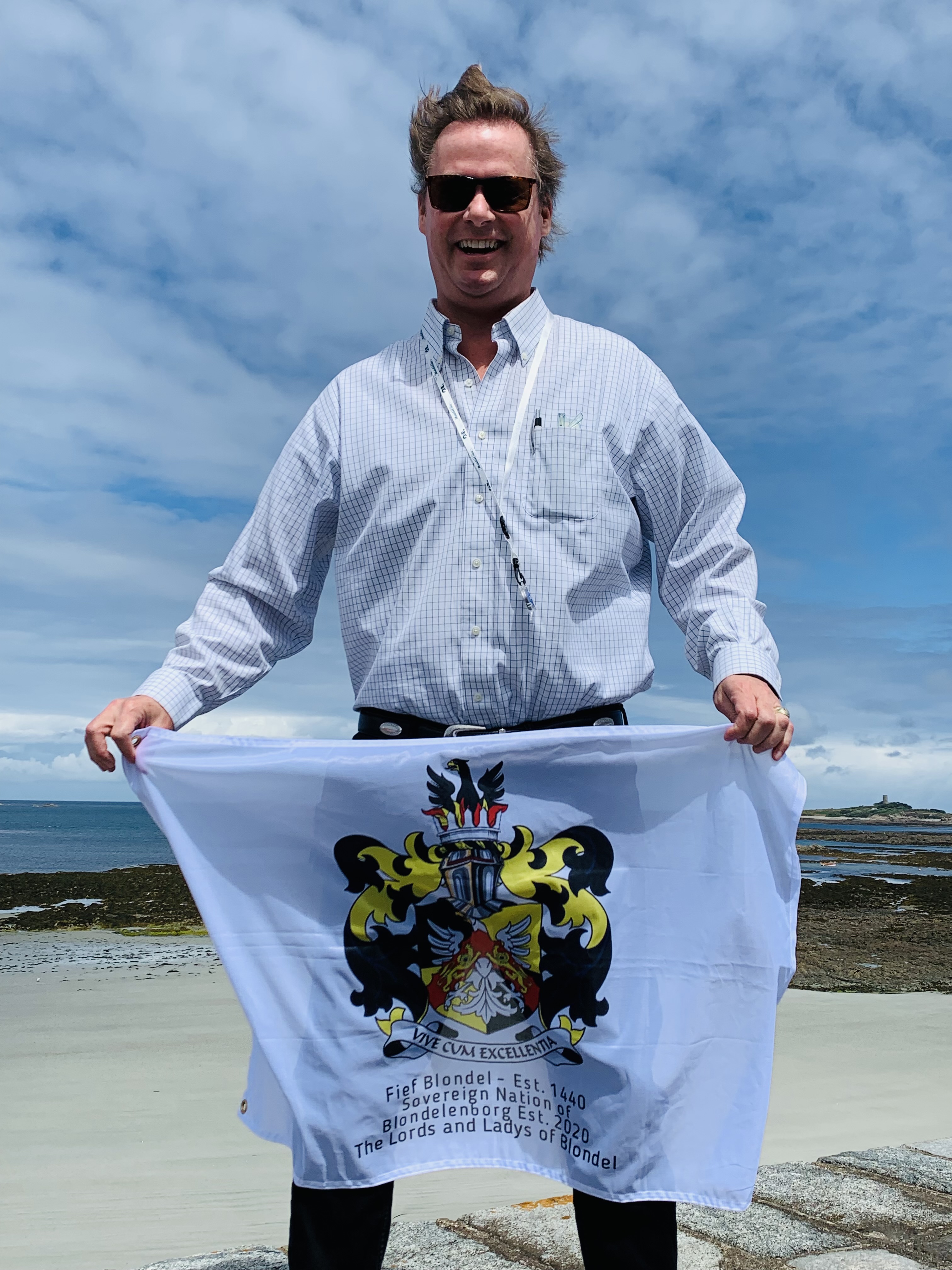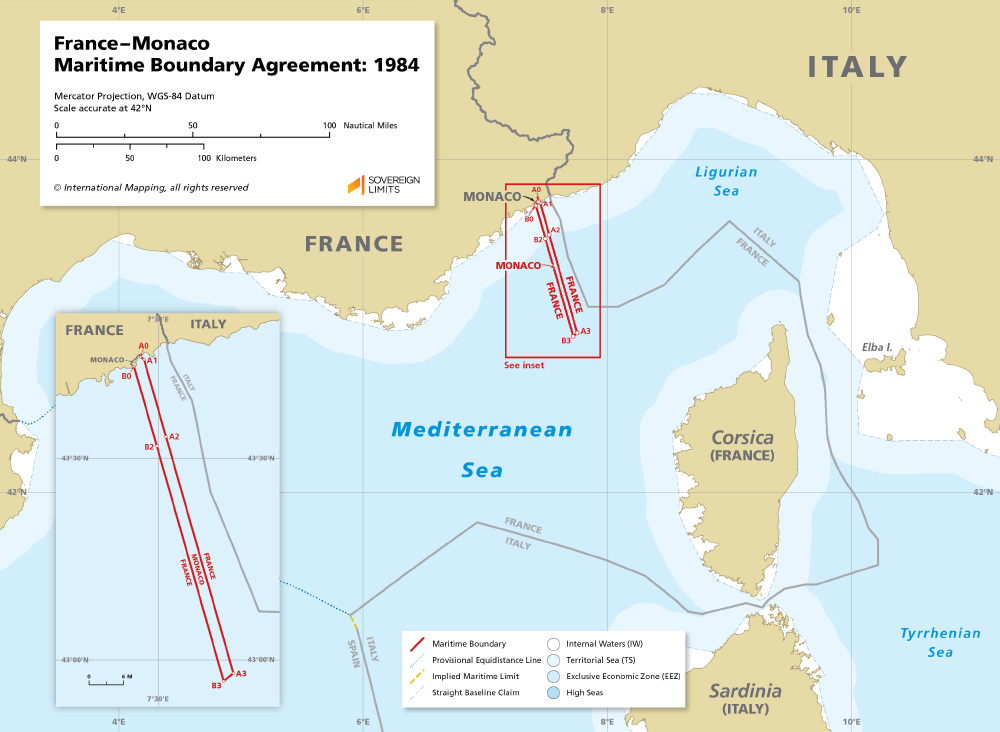

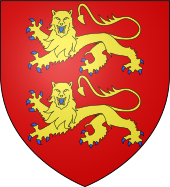
Sovereign Legal Rights of Private Noble Fief Owners to the Extended Continental Shelf : A Case Study of Independent Crown Holding of Guernsey in the Channel Islands
In 2018, the Fief of Blondel Claimed up to 200 miles of seasted and seabed under international law plus any
other seasted or seasted or continental shelf from its 3 beaches including all beaches, reefs, rocks, and
islands that apear at normal, high, or low tide extending out to sea using the Monaco Protocols for Territorial
Waters. France–United Kingdom
(Guernsey) Maritime Boundary | Sovereign Limits Fief Blondel has up to 500 yards of Beach
territory. 200 miles by 500 yards is approximately 36,363.64 acres.
or 48,400.55 vergees. The Fief of Blondel has 3 separate foreshores. Each are somewhat small, but add up to somewhere between 200 and 300 yards of length. If you multiply 200 yards times 15 Miles of Continental Shelf, you have over 1,000 acres of land which is over 2,600 Vergees of Land of Guernsey. Keep in mind, the largest Fief in Guernsey is Fief Le Roi which is 800 acres not including any shelf.
The concept of the extended continental shelf has gained significant attention in recent years as nations seek to establish their rights and jurisdiction over the resources of the seabed and subsoil beyond their territorial waters. This essay explores the legal rights of a private noble feudal owner of the foreshore and seasted on the island of Guernsey in the Channel Islands to the extended continental shelf in all directions from the beachhead to the sea. Recently, Japan which is an old feudal empire has discovered up to 26 Billion in Gold reserves on the foreshore or seasted. Japan Discovers Massive Treasure Trove Worth Over $26B, Enough to Support The Economy For Years With this in mind, anyone who owns foreshore, marinas, beaches, rocky shores, and offshore seasted and land must make a public notice such as this. To build a comprehensive argument, we will examine relevant international law, case law, and the unique historical and legal context of Guernsey. I. The Extended Continental Shelf: An Overview The extended continental shelf is a maritime zone that extends beyond a country's territorial waters and is governed by the United Nations Convention on the Law of the Sea (UNCLOS). UNCLOS defines the outer limits of a coastal state's continental shelf as the point where the seabed and subsoil meet the high seas or the area known as the "Area." The Area is under the international regime, but coastal states are entitled to sovereign rights over the resources of their extended continental shelf. II. The Case for Private Noble Feudal Owners in Guernsey 1. Historical Ownership: Guernsey, a Crown Dependency in the English Channel, has a unique feudal system dating back to medieval times. Under this system, private noble feudal owners hold rights to certain lands, beaches, foreshores, waters, and resources. Historically, these rights extended to the foreshore and seasted, allowing for ownership of coastal areas.
2. UNCLOS and Sovereign Rights: UNCLOS recognizes the sovereign rights of coastal states over their extended continental shelf. In the case of Guernsey, these rights extend from the beachhead to the sea, in alignment with the historical ownership rights of noble feudal owners. 3. Legal Precedent: There is countless relevant case law supporting the rights of private noble feudal owners in Guernsey below. In landmark cases such as La Pas Holdings, the Courts upheld the historical rights of noble feudal owners using precedent from over the last 1000 years, confirming their ownership of the foreshore and seasted. These ruling establishe a legal precedent aligning the historical rights of noble feudal owners with UNCLOS provisions regarding the extended continental shelf. 4. Maritime Boundaries Guernsey The maritime boundary separating France and the United Kingdom's Bailiwick of Guernsey was established through two distinct agreements. The first one, dating back to 1977, was determined by an arbitral tribunal as part of the broader boundary delineation between France and the United Kingdom concerning their continental shelves. This initial arrangement used the 12 nautical mile arcs from Guernsey's basepoints as the method for delimitation. Originally defined as a six-point line, the tribunal expanded it to twelve points in 1978. This boundary stretches across 64 nautical miles in a northeast to southwest direction. In 1992, France and the United Kingdom, acting on behalf of Guernsey, set up a fishing boundary in two sections that extend southward from the previously established maritime boundary until they meet the maritime area of the Bailiwick of Jersey. The eastern segment spans 29 nautical miles, while the western one covers 16 nautical miles. The equidistance methodology was employed by France and the United Kingdom to create this fisheries boundary.
Photo: Chancellor Mentz, Seigneur of Feif Blondel et Eperons seen flying the flag of Blondel over the Beaches Foreshore and Territorial Waters of Roquaine and Portelet
In 2019, the Bailiwick of Guernsey with approval of the Crown Holdings and Queen expanded its territorial sea claim from three nautical miles to twelve nautical miles. Presently, France and the United Kingdom are engaged in negotiations to establish an official territorial sea boundary between Guernsey and France.
200 Mile Limits The 200-mile maritime boundary is often referred to as the Exclusive Economic Zone (EEZ) or Extended Economic Zone. It is a zone of water that extends 200 nautical miles (approximately 230 regular miles or 370 kilometers) from a coastal state's baselines, such as its coastline or the outer edge of its territorial sea. Within this zone, the coastal state has special rights over the exploration and use of marine resources. Photo: Chancellor Mentz, Seigneur of Feif Blondel et Eperons seen flying the flag of Blondel over the Beaches Foreshore and Territorial Waters of Roquaine and Portelet
Key features of a 200-mile maritime boundary (EEZ) include: 1. Resource Rights: The coastal state within its EEZ has sovereign rights to explore and exploit natural resources found in the water column (such as fish) and on or beneath the seabed (such as oil, gas, and minerals). 2. Environmental Protection: The coastal state has a responsibility to protect and preserve the marine environment within its EEZ. 3. Scientific Research: Coastal states can conduct scientific research in their EEZ and on the continental shelf. 4. Jurisdiction over Activities: The coastal state has jurisdiction over various activities, including fishing, marine research, and the construction of artificial islands. The concept of a 200-mile EEZ is established under the United Nations Convention on the Law of the Sea (UNCLOS), which is an international treaty that governs the rights and responsibilities of countries concerning the world's oceans and their resources. UNCLOS was adopted in 1982 and has been ratified by many countries, making it the primary legal framework for maritime boundaries and ocean governance. It's important to note that while a 200-mile EEZ is the standard, some variations exist based on specific agreements between neighboring countries or unique geographical circumstances. Additionally, the exact boundaries of an EEZ can vary due to factors such as the presence of other coastal states, overlapping claims, and negotiations between countries. Seigneurs and Fiefs - 1000 Years of Rights in France and the UK The maritime rights of the Seigneurs of Monaco represent a fascinating historical aspect of both common law and civil law traditions that date back over a thousand years. Monaco, a tiny but strategically located principality on the French Riviera, has had a long-standing association with maritime activities due to its coastal location. The Seigneurs of Monaco, as the rulers of this region, held significant maritime rights and privileges throughout history. In common law systems, the concept of maritime rights of nobility has roots in medieval Europe. Seigneurs, as feudal lords, often possessed authority over coastal territories, granting them control over ports, fishing, and trade. These rights were recognized and enforced through customary law, laying the groundwork for later legal developments. Similarly, in civil law systems, Monaco's maritime rights have been governed by legal conventions and agreements. The establishment of maritime boundaries and fishing rights was crucial for coastal territories like Monaco. Historical conventions and treaties between Monaco and neighboring states, particularly France, have solidified these rights and defined the principality's maritime jurisdiction. For centuries, the Seigneurs of Monaco have navigated the complex legal landscape of maritime rights, balancing tradition with evolving international norms. Today, Monaco continues to exercise its maritime rights, playing a vital role in the principality's economy and cultural heritage. In 1984, France and Monaco defined their maritime boundary through a formal convention. This boundary is determined by a combination of loxodromes (rhumb lines) and an equidistance segment, forming an enclosed corridor that stretches southward from Monaco's coastline into the central Mediterranean Sea. The corridor has a width of two nautical miles and extends seaward for a distance of 100 nautical miles from Monaco's coast. The agreement to establish this narrow corridor was reached to ensure Monaco had a fair share of maritime space, considering its limited coastal front. Without this arrangement, Monaco's coastal access would have been significantly restricted by equidistance lines controlled by France's mainland coast on both sides. In conclusion, the maritime rights of the Lord Seigneurs and Dames of France Normandy and England showcase the enduring legacy of legal traditions in both common law and civil law systems. These rights, rooted in centuries of history, highlight the significance of coastal territories and their connection to the broader legal framework governing maritime activities.
III. UNCLOS and Territorial Sovereignty 1. UNCLOS Framework: UNCLOS provides a comprehensive framework for the delimitation of the extended continental shelf. It emphasizes the importance of equitable solutions and cooperation between neighboring coastal states. 2. Negotiations with Neighboring States: To exercise their rights over the extended continental shelf, private noble feudal owners in Guernsey may engage in negotiations with neighboring states, such as France and the United Kingdom. UNCLOS encourages peaceful negotiations and the avoidance of disputes. IV. Conclusion The legal rights of private noble feudal owners of the foreshore and seasted on the island of Guernsey to the extended continental shelf are grounded in historical ownership, UNCLOS provisions, and legal precedent. The "Guernsey Seasted Case" serves as a critical point of reference, affirming the alignment between historical ownership rights and UNCLOS principles. In the context of UNCLOS, private noble feudal owners in Guernsey have a legitimate claim to the extended continental shelf in all directions from the beachhead to the sea. However, it is essential that they engage in diplomatic negotiations with neighboring states to ensure the peaceful and equitable exercise of these rights while adhering to international law. In conclusion, the extended continental shelf is a complex legal and geographical concept that can be harmonized with historical ownership rights in unique cases like Guernsey. By respecting UNCLOS and engaging in diplomatic discussions, private noble feudal owners can assert their rights and contribute to the responsible management of maritime resources in the region.
Title: Guernsey's Private Fief Owners: Unique Custodians of Coastal and Marine Rights Introduction: The island of Guernsey, situated in the English Channel, is home to a rare and extraordinary legal tradition that grants private fief owners or seigneurs exclusive rights to the foreshore, territorial waters, and extended continental shelf property. This unique status elevates these individuals to a position akin to sovereign nations or kings, as they hold ownership over not only coastal resources but also the vast expanse of international waters and submerged land exposed by the sea. This essay delves into the exceptional position of Guernsey's private fief owners, highlighting their distinctive role as custodians of these valuable coastal and marine rights. I. Historical Origins: The roots of Guernsey's unique legal framework can be traced back to medieval times when the island was bestowed upon private fief owners by the Crown. These seigneurs became the feudal lords of Guernsey, inheriting not only land but also the rights to the foreshore and territorial waters. Over the centuries, this arrangement evolved to encompass the extended continental shelf, a concept recognized in modern international law. II. Contemporary Significance: In today's world, where coastal and marine resources are typically managed by governments or international bodies, Guernsey's private fief owners occupy an exceptional position. Their rights extend beyond the familiar boundaries of property ownership, granting them authority over extensive stretches of coastal and underwater terrain. III. Parallels with Sovereignty: The unique privileges afforded to private fief owners in Guernsey blur the lines between individual ownership and the authority traditionally associated with sovereign nations or monarchs. By owning not only land but also international waters and submerged territory, these seigneurs wield a level of influence and control rarely seen among private landowners. IV. Stewardship and Responsibility: With great power comes great responsibility, and private fief owners in Guernsey bear the duty of stewarding these valuable coastal and marine resources. Their role involves making decisions that impact not only the island's economy but also the delicate marine ecosystems and international waters surrounding Guernsey. V. Challenges and Considerations: The exceptional status of private fief owners in Guernsey brings both benefits and challenges. Balancing the preservation of tradition with contemporary environmental concerns and international legal obligations requires a delicate and thoughtful approach. Conclusion: For 600 years since the Deed of 1440 of The Fief de Thomas Blondel et Fief L'Eperons - In the Parishes of St Pierre du Bois and of Notre Dame de Torteval a certain fief called the fief Thomas Blondel being in the said parishes, parcel of the fief au Canely containing about three bouvées of land called the Bouvée Phlipot Pain, lying in the said parish of St Pierre du Bois, and the bouvées Torquetil and Bourgeon with the fief de l'Eperon lying in the said parish of Torteval. The deed in the University of Leeds conveys all and such seigneuries, dignities, liberties, graces and franchises as to the aforesaid fiefs. As of Jan 2024, Guernsey has not received the rights to beaches, foreshores, seabed, seasted, minerals, ECS, reefs, islands and rocks that are adjacent to the coastline. Thus, these rights still rest with Feudal Law where the Seigneur has inherent territorial rights shared with the Crown. Guernsey's private fief owners or seigneurs occupy a unique and exceptional position in the world, holding rights to the foreshore, territorial waters, and extended continental shelf property. This special status elevates them to a level of authority that parallels sovereign nations or monarchs, as they control not just coastal resources but also extensive international waters and submerged land. As custodians of these valuable assets, they face the dual responsibility of preserving tradition and safeguarding the environment. Guernsey's private fief owners are, indeed, a testament to the enduring legacy of a distinctive legal tradition that has persisted through the ages. Citations and References 2. Report - Foreshore Encroachment Policy Review - 14 January 2021.pdf (gov.je) 3. How autonomous are the Crown Dependencies? (parliament.uk) 4. Queen's foreshore gift could cost Islanders millions, warns advocate - Jersey Evening Post 5. Dependencies and Areas of Special Sovereignty - United States Department of State 6. Seabed mapping project helping to protect seagrass in Channel Islands (bbc.com) 7. Fief Blondel Beaches Ranked in the Best Portelet | Guernsey with Kids 8. States vote for Les Pas deal - Jersey Evening Post 9. 'Ancient property laws must be respected despite foreshore gift' - Jersey Evening Post 10. Extending the Bailiwick of Guernsey's Territorial Seas - States of Guernsey (gov.gg) 12. Jersey & Guernsey Law Review – June 2008 THE CUSTOMARY LAW about THE FORESHORE (1)" (PDF) . Retrieved 21 June 2023 . 13. Queen's foreshore gift could cost Islanders millions, warns advocate - Jersey Evening Post 14. S.O.U.L. (udallaw.com) & The Case for Udal Law. 15. International Law Relating to Islands | Brill 16. The Sovereignty of the Sea, by Thomas Wemyss Fulton.--a Project Gutenberg eBook 17. ch-12-legislative-system.pdf (gov.im) Isle of Man 18. im_31CommLWorldRev368.pdf (uniset.ca) Is the Isle of Man an Independent Nation 20. International Encyclopedia of Comparative Law - Google Books 21. https://www.earth.com/news/the-u-s-just-expanded-its-territory-by-a-million-square-kilometers/ 22. U.S. Extended Continental Shelf Project - United States Department of State 24. https://en.wikipedia.org/wiki/External_relations_of_Guernsey 25. https://www.royal.uk/crown-dependencies 26. https://www.sovereigngroup.com/sg-guernsey/ 27. No Capital Gains taxes on Guernsey or its Fiefs - TIES-Guernsey.pdf (SECURED) (kpmg.com) 28. Search (gov.je) Les Pas Holdings Case Law 29. P_2019_5_-_Extending_the_Bailiwick_of_Guernseys_Territorial_Seas.pdf (gov.gg) 31. Territorial waters - Wikipedia 32. Presently, the BBC and other news is unclear if the State or Crown claims any rights to foreshore or waters in Guernsey. Guernsey investigates taking seabed ownership from Queen - BBC News 33. Entire Bailiwick's territorial waters quadruple (bbc.com) 34. Royal Charters of Guernsey - Royal Court (guernseyroyalcourt.gg) 35. Royal charters applying to the Channel Islands - Wikipedia 36. The Queen’s Gift Saga – Report – SOS Jersey 37. Guernsey investigates taking seabed ownership from Queen - BBC News 38. Extending the Bailiwick of Guernsey's Territorial Seas - States of Guernsey (gov.gg) 40. Who owns the seabed, and why it matters (senedd.wales) 41. How the Queen came to own the seabed around Britain | Wind power | The Guardian 42. Republics of the Reefs: Nation-Building on the Continental Shel.pdf (cwsl.edu) 43. Monaco Maritime claims - Geography (indexmundi.com)
There is matter of ownership of the foreshore and seabed of the territorial sea after extension to 12 nm. Insofar as Guernsey is concerned ownership of the majority of the foreshore and the seabed of the territorial sea surrounding Guernsey was vested in the Seigneurs/Fiefs and the Lord of the Islands Crown; but the Crown may have abandoned or released any of their Crown water rights to island feif owners which includes the Fief Seigneurs. In the Les Pas case, the government had to pay 10 Million the Seigneur for rights to the foresshore and ocean access. This is different from the situation in the Isle of Man and Jersey for example where, in the case of the Isle of Man, ownership of the seabed is vested in the Isle of Man government and, in the case of Jersey, ownership of both the foreshore and the seabed is now vested in the people of Jersey (as represented by Her Majesty's Attorney General for Jersey).
Monarchs and Principalities As with Sultans, Lords, Fiefs, and Monarchs throughout Arabia, Pacific, Africa and other regions, the rights to the territorial waters, fishing, reefs, etc extend 200 miles or so on most maps. The Status of Pacific Regional Maritime Boundaries as of July 2020 | SPC Geoscience, Energy and Maritime Division Examples: Territorial Waters, Extended Continental Shelf, and Fishing Rights for Maldives, Nauru, and Tuvalu: Maldives: Territorial Waters: The territorial waters of the Maldives
extend up to 12 nautical miles (22.2 kilometers) from its baselines, including the atolls and islands. Nauru: Territorial Waters: Nauru's territorial waters extend up to 12
nautical miles from its baselines, which encompass the island. Tuvalu: Territorial Waters: Tuvalu's territorial waters extend up to
12 nautical miles from its baselines, covering its low-lying atolls.
References for Maldives: Maldives Marine Research Institute: https://www.mrc.gov.mv/ UNCLOS Text: https://www.un.org/depts/los/convention_agreements/texts/unclos/unclos_e.pdf UNCLOS: https://www.un.org/depts/los/convention_agreements/texts/unclos/unclos_e.pdf International Tribunal for the Law of the Sea (ITLOS):
https://www.itlos.org/
Description of the Lords of The European Fief of Blondel and Eperons - Est. 1179 Commissioner George Mentz is the Seigneur of the Fief Blondel & Eperons of Normandy which is an 800 year old territory on the Norman Islands. From the great Viking Rollo to the present day of the rule of King Charles, these islands have allowed feudal law and courts on the fiefs and island shores. The Fief Blondel and Eperons and its Seigneur are registered directly with the Royal Courts of the Crown and The Duke of Normandy and King Charles. Much like the Seigneurs of Monaco, the lords of French Andorra, Sovereign Gozo of Malta, the Sovereign Military Order of Malta (SMOM), The Papal Monarch of the Vatican City, and The Lord of Sark, The ancient Fiefs in the Channel islands are recognized by both nobility law and international law. Commissioner Dr. George Mentz was elevated as the 26th Free Lord & Seigneur of Fief of Blondel et L'Epersons) on the island of (Dgèrnésiais - Guernsey French) in Dec. 2017. Mentz also registered the fief direct with the courts using the feudal legal system of Conge and Tresieme which is the official way to transfer a fief from one noble leader or peer to another owner. The Fief of Thom. Blondel is One of the Last Great Private Fiefs in Europe to be privately owned where the lord owns the Beaches, Water, Foreshores and Seasteds including international Waters. In other local cultures, the free-lord Seigneur is known as a Frhr. Friherre in Sweden, a Frhr. Vrijheer in Dutch, and a Frhr. Friherre in Denmark. The Lords of Fief Blondel et Eperons appear to be older than the Seigneurs of Monaco as the Grimaldi family settled in Monaco in 1297 and Fief Blondel is also older than ancient Sheikhdom of Kuwait, Kingdom of Moscovy Russia 1362, Kingdom of Spain 1479, Kingdom of Bohemia, Kingdom of Belgium. Fief Blondel may also be older than the Ottoman Empire, Habsburg Empire, and the Kingdom of Lithuania. French: Le commissaire George Mentz est le seigneur du fief Blondel & Eperons de Normandie, un territoire vieux de 800 ans situé sur les îles normandes. Du grand Viking Rollo jusqu'à l'époque actuelle du règne du roi Charles, ces îles ont permis l'application du droit féodal et des tribunaux sur les fiefs et les côtes des îles. Le fief Blondel et Eperons ainsi que son seigneur sont enregistrés directement auprès des Cours Royales de la Couronne, du Duc de Normandie et du Roi Charles. Tout comme les seigneurs de Monaco, les seigneurs de la France, Andorre, le Souverain Gozo de Malte, l'Ordre Souverain Militaire de Malte (SMOM), le Monarque Papal de la Cité du Vatican et le Seigneur de Sark, les anciens fiefs des îles de la Manche sont reconnus à la fois par le droit de la noblesse et par le droit international. Le commissaire George Mentz a été élevé au rang de 26ème Seigneur Libre et Seigneur du fief de Blondel et L'Epersons) sur l'île de (Dgèrnésiais - français de Guernesey) en décembre 2017. Mentz a également enregistré le fief directement auprès des tribunaux en utilisant le système juridique féodal de Conge et Tresieme, qui est la manière officielle de transférer un fief d'un noble leader ou pair à un autre propriétaire. Le fief de Thom. Blondel est l'un des derniers grands fiefs privés en Europe à être la propriété privée où le seigneur possède les plages, l'eau, les rivages et les estrades maritimes, y compris les eaux internationales. Dans d'autres cultures locales, le seigneur libre Seigneur est connu sous le nom de Frhr. Friherre en Suède, un Frhr. Vrijheer en néerlandais, et un Frhr. Friherre au Danemark. Les seigneurs du fief Blondel et Eperons semblent être plus anciens que les seigneurs de Monaco car la famille Grimaldi s'est installée à Monaco en 1297 et le fief Blondel est également plus ancien que l'ancien émirat du Koweït, le royaume de Moscovy Russie 1362, le royaume d'Espagne 1479, le royaume de Bohème, le royaume de Belgique. Le fief Blondel pourrait également être plus ancien que l'Empire ottoman, l'Empire des Habsbourg et le royaume de Lituanie. German: Kommissar George Mentz ist der Seigneur des Fiefs Blondel & Eperons der Normandie, das ein 800 Jahre altes Territorium auf den Normanneninseln ist. Von dem großen Wikinger Rollo bis zur heutigen Zeit unter der Herrschaft von König Charles haben diese Inseln feudales Recht und Gerichte auf den Lehen und Inselküsten ermöglicht. Das Fief Blondel und Eperons sowie sein Seigneur sind direkt bei den Königlichen Gerichten der Krone, dem Herzog der Normandie und König Charles registriert. Ganz ähnlich wie die Seigneurs von Monaco, die Herren von Frankreich, Andorra, dem Souveränen Gozo von Malta, dem Souveränen Militärorden von Malta (SMOM), dem päpstlichen Monarchen des Vatikanstaats und dem Herrn von Sark werden die alten Lehen auf den Kanalinseln sowohl vom Adelsrecht als auch vom Völkerrecht anerkannt. Kommissar Dr. George Mentz wurde im Dezember 2017 zum 26. Freien Herrn & Seigneur des Fiefs von Blondel et L'Epersons) auf der Insel (Dgèrnésiais - Guernsey French) erhoben. Mentz registrierte das Lehen auch direkt bei den Gerichten unter Verwendung des feudalen Rechtssystems von Conge und Tresieme, das die offizielle Art und Weise ist, ein Lehen von einem adligen Führer oder Peer auf einen anderen Eigentümer zu übertragen. Das Fief von Thom. Blondel ist eines der letzten großen privaten Lehens in Europa, das privat besessen ist, wo der Herr die Strände, das Wasser, die Küsten und die Meeresstädte einschließlich der internationalen Gewässer besitzt. In anderen lokalen Kulturen ist der freie Herr Seigneur als Frhr. Friherre in Schweden, ein Frhr. Vrijheer im Niederländischen und ein Frhr. Friherre in Dänemark bekannt. Die Herren des Fiefs Blondel et Eperons scheinen älter zu sein als die Seigneurs von Monaco, da sich die Familie Grimaldi 1297 in Monaco niederließ und das Fief Blondel auch älter ist als das alte Scheichtum Kuwait, das Königreich Moscovy Russland 1362, das Königreich Spanien 1479, das Königreich Böhmen, das Königreich Belgien. Das Fief Blondel könnte auch älter sein als das Osmanische Reich, das Habsburgerreich und das Königreich Litauen. Italian: Il commissario George Mentz è il signore del Feudo Blondel & Eperons della Normandia, un territorio di 800 anni situato nelle isole normanne. Dal grande vichingo Rollo ai giorni nostri sotto il regno di Re Carlo, queste isole hanno permesso l'applicazione della legge feudale e dei tribunali sui feudi e sulle coste delle isole. Il Feudo Blondel ed Eperons e il suo signore sono registrati direttamente presso i Tribunali Reali della Corona, il Duca di Normandia e Re Carlo. Molto simili ai signori di Monaco, i signori della Francia, Andorra, il Sovrano Gozo di Malta, il Sovrano Militare Ordine di Malta (SMOM), il Monarca Papale della Città del Vaticano e il Signore di Sark, gli antichi Feudi delle isole del Canale sono riconosciuti sia dalla legge nobiliare che dal diritto internazionale. Il commissario Dr. George Mentz è stato elevato al rango di 26° Signore Libero & Signore del Feudo di Blondel et L'Epersons) nell'isola di (Dgèrnésiais - Guernsey French) nel dicembre 2017. Mentz ha anche registrato il feudo direttamente presso i tribunali utilizzando il sistema giuridico feudale di Conge e Tresieme, che è il modo ufficiale per trasferire un feudo da un nobile leader o pari a un altro proprietario. Il Feudo di Thom. Blondel è uno degli ultimi grandi feudi privati in Europa a essere di proprietà privata, dove il signore possiede le spiagge, l'acqua, le rive e le città marittime, comprese le acque internazionali. In altre culture locali, il Signore libero Seigneur è conosciuto come Frhr. Friherre in Svezia, un Frhr. Vrijheer in olandese e un Frhr. Friherre in Danimarca. I Signori del Feudo Blondel et Eperons sembrano essere più antichi dei Signori di Monaco, poiché la famiglia Grimaldi si stabilì a Monaco nel 1297 e il Feudo Blondel è anche più antico dell'antico sceicco del Kuwait, del Regno di Moscovia Russia 1362, del Regno di Spagna 1479, del Regno di Boemia, del Regno del Belgio. Il Feudo Blondel potrebbe anche essere più antico dell'Impero Ottomano, dell'Impero degli Asburgo e del Regno di Lituania. Spanish: El comisionado George Mentz es el Señor del Feudo Blondel & Eperons de Normandía, un territorio de 800 años en las Islas Normandas. Desde el gran vikingo Rollo hasta la actualidad bajo el reinado del Rey Carlos, estas islas han permitido la aplicación de la ley feudal y los tribunales en los feudos y las costas de las islas. El Feudo Blondel y Eperons y su Señor están registrados directamente en los Tribunales Reales de la Corona, el Duque de Normandía y el Rey Carlos. Al igual que los Señores de Mónaco, los señores de Francia, Andorra, el Soberano Gozo de Malta, la Orden Militar Soberana de Malta (SMOM), el Monarca Papal de la Ciudad del Vaticano y el Señor de Sark, los antiguos Feudos de las Islas del Canal son reconocidos tanto por la ley nobiliaria como por el derecho internacional. El comisionado Dr. George Mentz fue elevado al rango de 26º Señor Libre y Señor del Feudo de Blondel et L'Epersons) en la isla de (Dgèrnésiais - Guernsey French) en diciembre de 2017. Mentz también registró el feudo directamente en los tribunales utilizando el sistema legal feudal de Conge y Tresieme, que es la forma oficial de transferir un feudo de un líder noble o par a otro propietario. El Feudo de Thom. Blondel es uno de los últimos grandes feudos privados en Europa en ser de propiedad privada, donde el señor posee las playas, el agua, las costas y las ciudades marítimas, incluidas las aguas internacionales. En otras culturas locales, el Señor libre Señor se conoce como Frhr. Friherre en Suecia, un Frhr. Vrijheer en holandés y un Frhr. Friherre en Dinamarca. Los Señores del Feudo Blondel et Eperons parecen ser más antiguos que los Señores de Mónaco, ya que la familia Grimaldi se estableció en Mónaco en 1297 y el Feudo Blondel también es más antiguo que el antiguo jeque del Kuwait, el Reino de Moscovia Rusia 1362, el Reino de España 1479, el Reino de Bohemia, el Reino de Bélgica. El Feudo Blondel también podría ser más antiguo que el Imperio Otomano, el Imperio de los Habsburgo y el Reino de Lituania.
Seigneurs of Blondel claims the same as the Seigneurs of Monaco but Blondel also claims other rights to light, airspace, airwaves, minerals, fishing, port of entry, drilling etc.
Maritime claims: territorial sea: 12 nm
Definition: This entry includes the following claims, the definitions of which are
excerpted from the United Nations Convention on the Law of the Sea (UNCLOS), which alone contains the full and
definitive descriptions: | |||||||
Seigneur de la Fief of Blondel Lord Baron Mentz of Fief Blondel Geurnsey Crown Dependency Seigneur Fief of Blondel George Mentz Lord Baron of Fiefdom Blondel Freiherr of Fief Thomas Blondel Feudal Lord of Baronnie - Noble Fief Barony Friherre > ECS Extended Continental Shelf Seigneurs and Dames Travel Research Lord Paramount Feudal Barons The Seigneur Order Patron George Mentz Charter of Liberties Deed & Title Fief Blondel Islands Viking Kingdom Fief Worship Fiefs of the Islands ECS Extended Continental Shelf Styles and Dignities Territorial Waters Blondel Privy Seal Fief Bouvees of Fief Thomas Blondel Guernsey Court of Chief Pleas Fief Court Arms Motto Flower Fief de l'Eperon La Genouinne Kingdom of West Francia Fief DuQuemin Bouvée Phlipot Pain Bouvée Torquetil Bouvée Bourgeon Bailiwick of Ennerdale Channel Island History Fief Direct from the Crown A Funny Think Happened On the Way to the Fief Guernsey Bailiwick of Guernsey - Crown Dependency Confederation des Iles Anglo-Normandes Sovereignty Papal Bull Research Links Norse Normandy Order of the Genet Order of the Genet Order of the Star Est. 1022 Knights of theThistle of Bourbon Count of Anjou Fief Rights Blondel and King Richard Press Carnival Manorial Incidents Appointments of Seigneurs Store Portelet Beach Roquaine Bay Neustrasia Columbier Dovecote Fief Blondel Merchandise Fief Blondel Beaches Islands Foreshore Events Fiefs For Sale Sold Lords of Normandy Fief Coin Viscounts de Contentin Fief Blondel Map Feudal Guernsey Titles Board of Trustees The Feudal System Hereditaments Chancellor Flag & Arms Fief Videos Guernsey Castle Sark Contact Advowson Site Map Disclaimer Freiherr Livres de perchage Lord Baron Longford Income Tax Guernsey Valliscaulian Order Saint Benedict of the Celestines Society of Divine Compassion Dictionary Count of Mortain Seigneur de Saint-Sauveur Seigneur of Fief Ansquetil Top Success Books Datuk Seri George Mentz Order St. Benedict OSB Celestines Order of the Iron Crown Order of the White Falcon Colonel Mentz Order Red Eagle Order St. Louis Order Holy Ghost Order of Saint Anthony Order of the Black Swan Order of St Columban Order of the Iron Helmet Livonian Brothers of the Sword Fief treizième and Direct from Crown Valuation Fief Blondel Prince of Annaly Teffia
Feudal Lord of the Fief Blondel of the Nordic Channel Islands Guernsey Est.
1179
Feudalherr - Fief Blondel von der Nordischen Insel Guernsey Est. 1179
New York Gazette - Magazine of Wall Street -
George Mentz -
George Mentz - Aspen Commission - Mentz Arms
Counselor George Mentz Esq. - Seigneur Feif BlondelBaron Annaly Baron Moyashel Grants to Delvin About Longford Styles and Dignities The Seigneur Court Barons Fiefs of the Islands Longford Map The Island Lords Market & Fair Fief Worship Channel Island History Fief Blondel Lord Baron Longford Fief Rights Fief Blondel Merchandise Events Blondel and King Richard Fief Coin Feudal Guernsey Titles The Feudal System Flag & Arms Castle Site Map Disclaimer Blondel Myth DictionaryMentz Scholarship Program 101 Million Donation - Order of the Genet Knighthood |
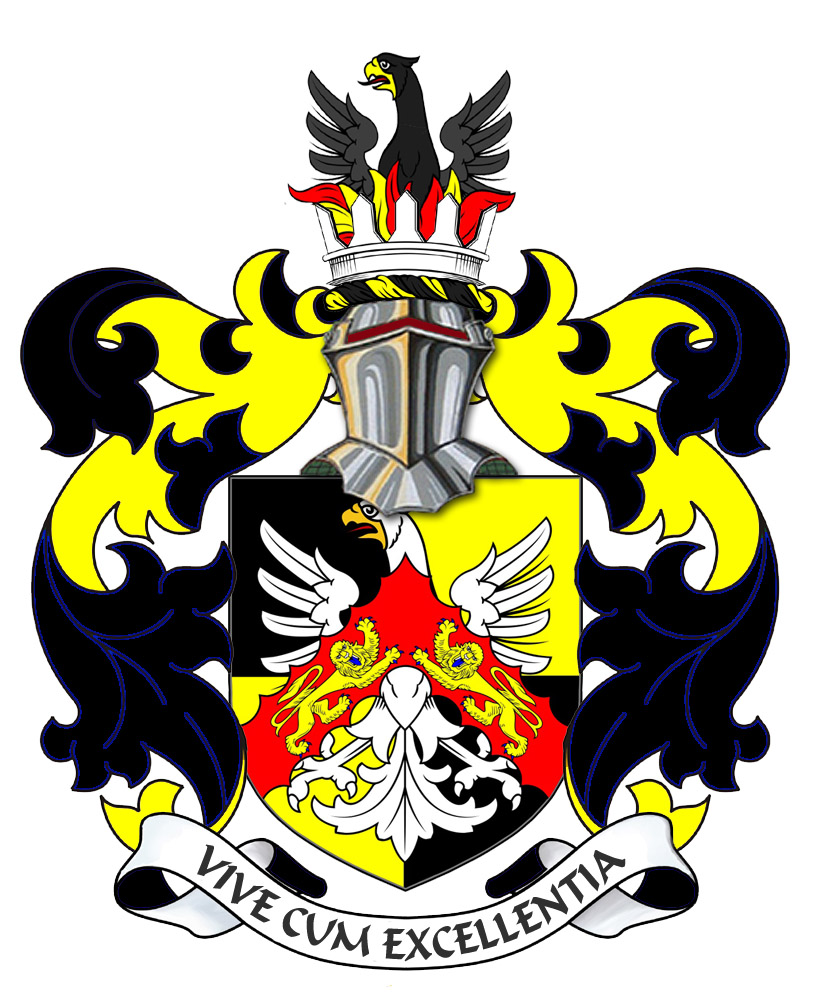

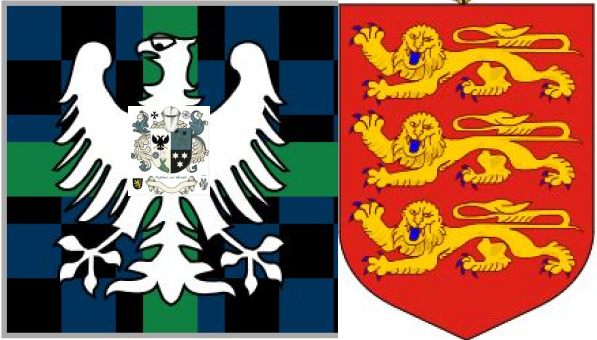
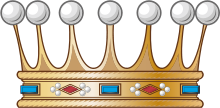

George Mentz Education -
Commissioner George Mentz
-
https://finance.yahoo.com/news/commissioner-george-mentz-clinches-influencer-180000705.html
-
George Mentz News -
George Mentz Net Worth - George Mentz Noble Tilte -
George Mentz -
George Mentz Trump Commissioner -
George Mentz Freiherren Count Baron -
George Mentz Global Economic Forum -
George Mentz Donates Millions
